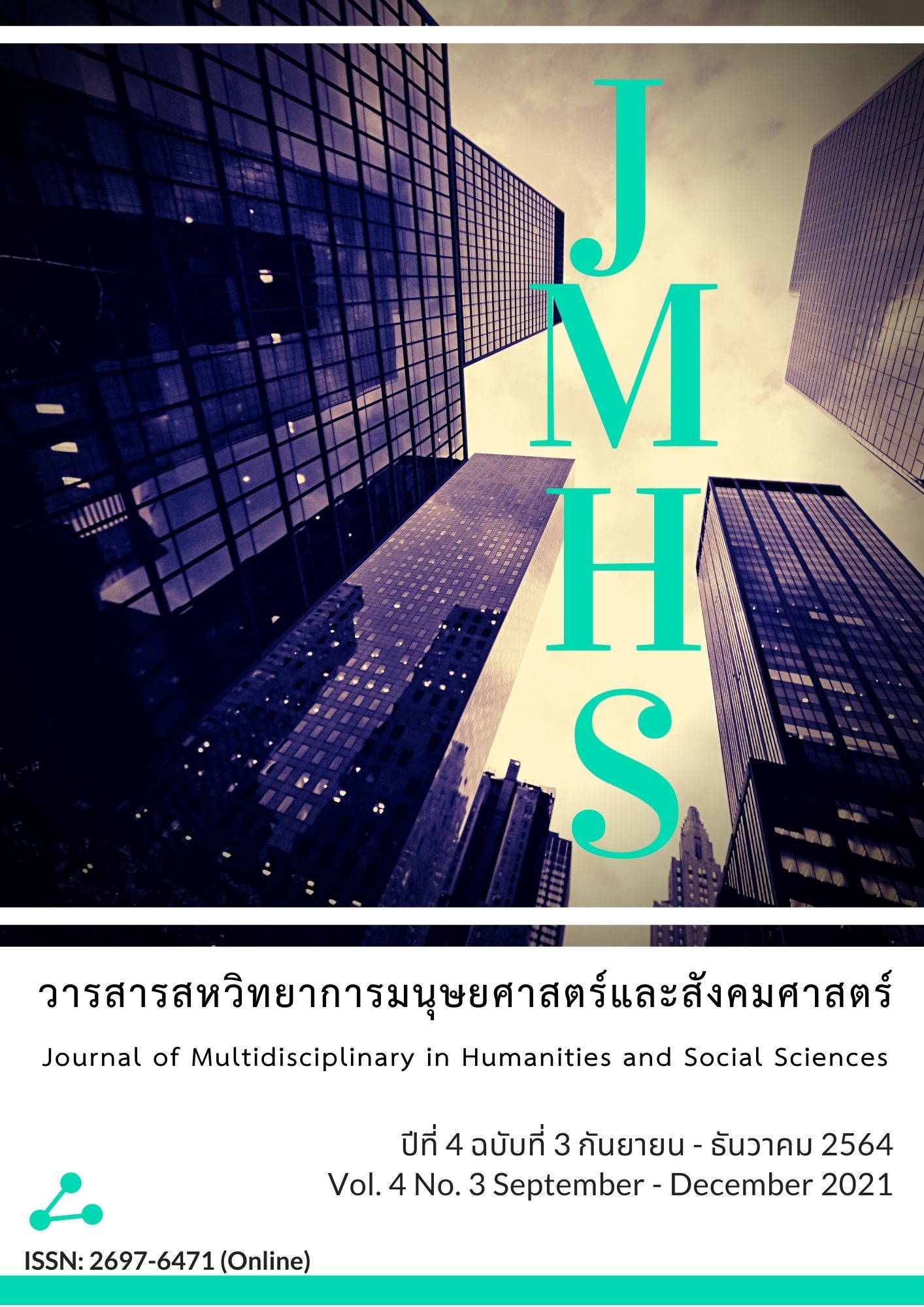Diagnosis of Mathematical Defects in Addition, Subtraction, Multiplication, and Division of Prathom Sueksa Four Students at Schools in the Service Area of Chang Khwa Subdistrict Municipality, Kanchanadit District, Suratthani Province
Main Article Content
Abstract
The purpose of this research was to diagnose the mathematical defects, in addition, subtraction, multiplication, and division of Prathom Sueksa Four students at schools in the service area of Chang Khwa subdistrict municipality, Kanchanadit district, Surat Thani province in three aspects, namely, the understanding of theorems and definitions; computational thinking; and the interpretation of problems. The sample population consisted of seventy-four Prathom Sueksa Four students from a total of ninety-nine students in the academic year of 2020 from six schools in the service area of Chang Khwa subdistrict municipality, Kanchanadit district, Surat Thani province. Members of the sample population consisted of eleven students from Ban Saphan Kathin School, twelve students from Ban Hua Mak Lang School, thirteen students from Wat Phut School, twenty students from Ban Sai To School, fourteen students from Ban Huai Sok School, and four students from Ban Mamuang Wan School. The research instrument was a mathematics diagnostic test on addition, subtraction, multiplication, and division for Prathom Sueksa Four students. The test was in the form of four-multiple choices with a parallel test of fifteen pairs with a total of thirty items.
Findings were as follows:
1. For the aspect of using the definitions concerning errors in understanding, remembering theorems, formulas, definitions, and properties wrongly, or applying definitions incorrectly. It was the students who answered wrongly at 63.5 percent. it was found that the students could not explain what a picture indicated or what a picture meant.
2. For the aspect of calculation concerned with the errors from calculations, calculation skills, showing methods of finding answers and solving basic problems, in addition, subtraction, multiplication, division, as well as incorrect addition, subtraction, multiplication, and division. It was the students who answered wrongly at 60.8 percent.
3. For the aspect of the interpretation of the problems concerned with changing the interpretation of the meaning from language sentences to symbol sentences incorrectly in the matters of addition, subtraction, multiplication, and division. It was the students answered wrongly at 68.9 percent. The item the students who answered wrongly at the highest level was the item asking the students to write a symbol sentence from a language sentence. Next in descending order was the language problem for the students who were unable to select the correct answer.
The findings from this research can be applied in teaching and learning management by informing teachers of the problems identified in the research results in all three areas and can be used to improve teacher teaching and repair teaching can be added on the spot, resulting in students having basic knowledge for further study.
Article Details
Views and opinions appearing in the Journal it is the responsibility of the author of the article, and does not constitute the view and responsibility of the editorial team.
References
กระทรวงศึกษาธิการ. (2551). หลักสูตรแกนกลางการศึกษาขั้นพื้นฐาน พ.ศ. 2551. กรุงเทพฯ: โรงพิมพ์ชุมนุมสหกรณ์การเกษตรแห่งประเทศไทย.
ญาณัจฉรา สุดแท้. (2551). การสร้างแบบทดสอบวินิจฉัยทางการเรียนกลุ่มสาระการเรียนรู้คณิตศาสตร์ เรื่องความสัมพันธ์ระหว่างรูปเรขคณิตสองมิติและสามมิติ สำหรับนักเรียนชั้นมัธยมศึกษาปีที่ 1(วิทยานิพนธ์ปริญญามหาบัณฑิต). มหาวิทยาลัยสารคาม.
นิรุธ จอมพุก, วารุณี ลัภนโชคดี และ ชานนท์ จันทรา. (2561). การสร้างแบบทดสอบวินิจฉัยข้อบกพร่องทางการเรียนคณิตศาสตร์สาระที่ 4 พีชคณิต สำหรับนักเรียนชั้นประถมศึกษาปีที่ 6 สังกัดสำนักงานเขตพื้นที่การศึกษาประถมศึกษาลพบุรี เขต 2. วารสารรัชต์ภาคย์, 12(27), 170-182.
ไพศาล ดาแร่, ฟ้าอาทิตย์ ท่อนทองทิพย์ และ วสวัตติ์ แก้วมาก. (2557). การสร้างระบบแบบทดสอบเพื่อวินิจฉัยข้อบกพร่องทางการเรียนรู้คณิตศาสตร์ สาระที่ 4 พีชคณิต เรื่องการแก้โจทย์ปัญหาด้วยสมการ สำหรับนักเรียนชั้นประถมศึกษาปีที่ 6. วารสารโครงงานวิทยาการคอมพิวเตอร์และเทคโนโลยีสารสนเทศ, 4(1), 51-59.
เบญจมาศ พุทธิมา. (2556). การพัฒนาแบบทดสอบวินิจฉัยด้วยโปรแกรมคอมพิวเตอร์วิชาคณิตศาสตร์ เรื่อง การคูณและการหาร ชั้นประถมศึกษาปีที่ 4 สำนักงานเขตพื้นที่การศึกษาประถมศึกษาเชียงราย เขต 2. วารสารการวิจัยกาสะลองคำ มหาวิทยาลัยราชภัฏเชียงราย, 7(2), 11-21.
ฟาฏินา วงศ์เลขา. (2553). การเรียนคณิตศาสตร์: ความจําเป็นที่ไม่ควรมองข้าม. สืบค้นเมื่อ 28 เมษายน 2564, จาก http://social.obec.go.th/node/22
สถาบันทดสอบทางการศึกษาแห่งชาติ. (2563). ผลคะแนนสอบ O-NET ปีการศึกษา 2562 ชั้นประถมศึกษาปีที่ 6. สืบค้นเมื่อ 28 เมษายน 2563, จาก http://www.niest.or.th
สินี โดดหนู. (2561). การวินิจฉัยข้อกพร่องทางการเรียนคณิตศาสตร์ เรื่อง ทศนิยม สำหรับนักเรียนชั้นประถมศึกษาปีที่ 6 โรงเรียนในสังกัดสำนักงานคณะกรรมการส่งเสริมการศึกษานอกชน เขตพื้นที่ประถมศึกษากรุงเทพมหานคร เขต 2(วิทยานิพนธ์ศึกษามหาบัณฑิต). มหาวิทยาลัยรามคำแหง.
นราทิพย์ ใจเพียร และ จารุวรรณ สิงห์ม่วง. (2562). การพัฒนาผลสัมฤทธิ์ทางการเรียนคณิตศาสตร์เรื่อง การบวก ลบ ทศนิยม สำหรับนักเรียนชั้นประถมศึกษาปีที่ 4 โดยใช้แบบฝึกทักษะ. วารสารวิชาการมหาวิทยาลัยราชภัฏศรีสะเกษ, 13(3), 49-57.
สุทธิพร สุดพรหม, (2563). การพัฒนารูปแบบการสอน 2S Model สำหรับใช้ในการแก้โจทย์ปัญหาวิชาคณิตศาสตร์ระดับมัธยมศึกษาตอนต้น สังกัดสำนักงานศึกษาธิการ จังหวัดปทุมธานี. วารสารสังคมศาสตร์และมานุษยวิทยาเชิงพุทธ, 5(4), 281-292.
ภัทริกา อาจจุลฬา, เอกราช ดีนาง และ พัชรินทร์ ชมภูวิเศษ. (2562). การสร้างแบบทดสอบวินิจฉัยจุดบกพร่องทางการเรียนวิชาคณิตศาสตร์ เรื่อง การวัดของนักเรียนชั้นประถมศึกษาปีที่ 5 สังกัดสำนักงานเขตพื้นที่การศึกษาประถมศึกษาเลย เขต 1. วารสารวิชาการและวิจัย มหาวิทยาลัยภาคตะวันออกเฉียงเหนือ, 9(2), 35-46.
Krejcie, R. V., & Morgan, D. W. (1970). Determining Sample Size for Research Activities. Education and Psychological Measurement, 30(3), 607–610.


